Audio Performance
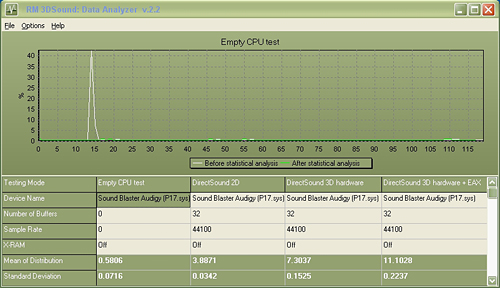
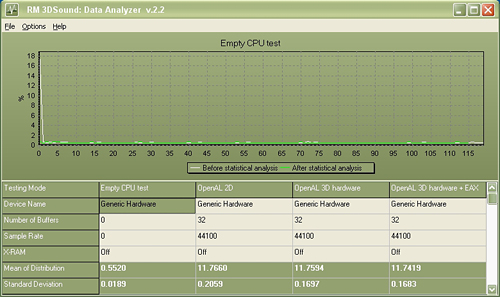
We limited audio testing to the Rightmark 3D Sound version 2.2 CPU utilization test and tested with sound enabled to show the performance effects on several games. The Rightmark 3D Sound benchmark measures the overhead or CPU utilization required by a codec or hardware audio chip.
The Realtek HD audio codec family was tested with the recently released 1.34 driver set and the Realtek AC97 codecs with the 3.84 driver set. We tested the Sound Blaster Audigy SE with the 5.12.1.519 driver set. The Realtek HD DirectSound audio drivers do not support more than 32 hardware buffers and the OpenAL 1.1 drivers do not support more than 30 hardware buffers at this time so the scores cannot be directly compared to the Creative Labs Sound Blaster X-FI and Sound Blaster Audigy SE in the benchmarks.
Although Creative Labs is marketing the CA0106-DAT codec as a Sound Blaster Audigy SE, it is actually the same chipset used in the Sound Blaster Live! 24-bit family of products. The CA0106-DAT is paired with the excellent Wolfson WM8775 ADC and Cirus Logic CS4382 DAC to provide 8-channel audio capability, 100dB SNR rating, and 24-bit/96KHz operation. This combination fully supports EAX 1/2/3 and OpenAL 1.1 but did not provide EAX3 (HD) positional audio via hardware in our testing.
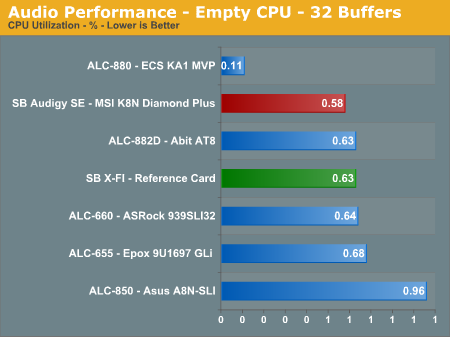
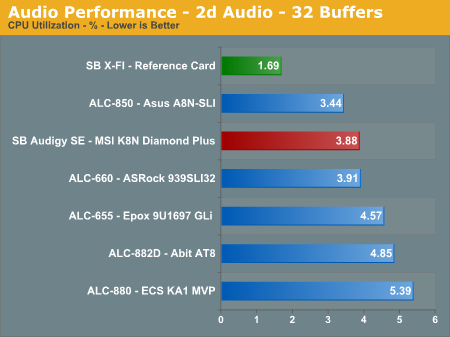
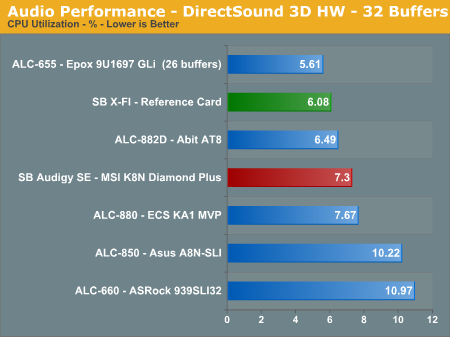
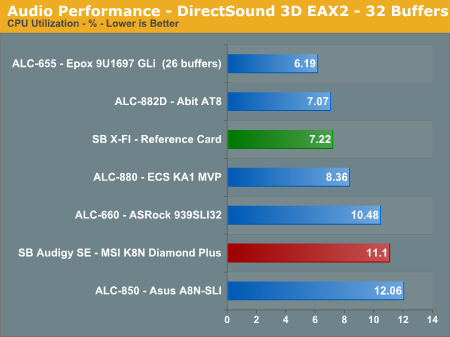
The Sound Blaster Audigy SE codec offers competitive CPU utilization rates when compared to the Realtek series of codecs. The SB Audigy SE generates better gaming audio quality than the Realtek ALC-882 based systems and similar DVD/music audio quality. In our subjective headphone testing we noticed differences between the two codecs, with the output from the ALC-882 sounding cleaner in the mid-range tones with deeper bass in the music and DVD movie playback tests while ambient sounds and positioning in the games tests clearly favored the SB Audigy SE. However, the difference was minor when utilizing our 4, 5.1, or 7.1 speaker setup in a typical room environment. The Sound Blaster X-FI has the lowest overall rates with the Realtek solutions and SB Audigy SE following closely. Let's find out how these results translate into real world numbers.
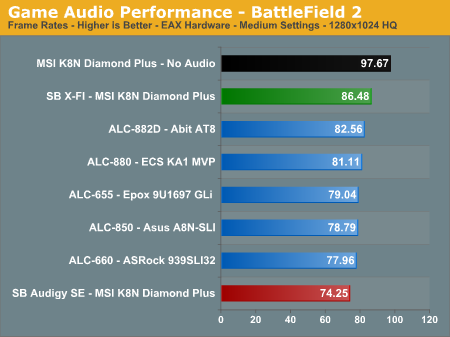
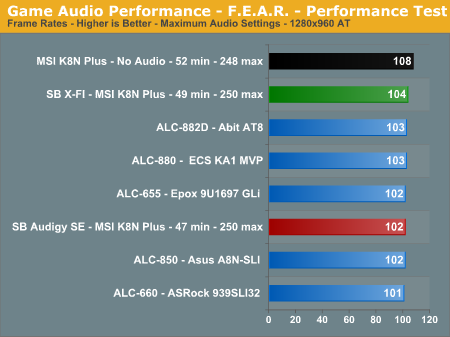
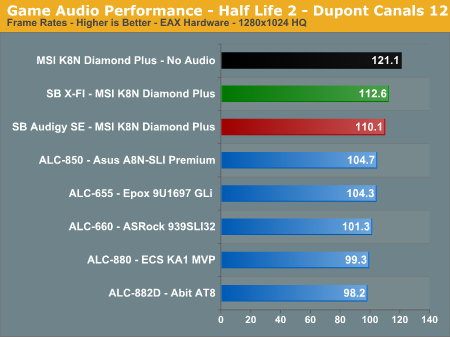
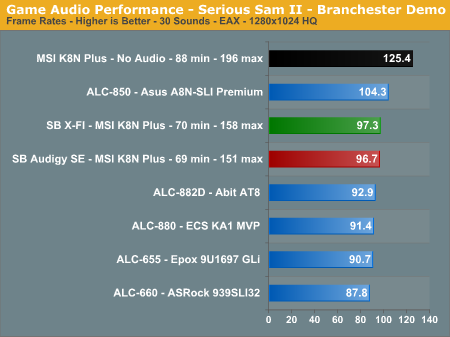
The audio performance numbers remain consistent as the Sound Blaster Audigy SE finishes behind the SoundBlaster X-FI while trading places with the Realtek audio solutions. Serious Sam II has an average loss of 30%, Battlefield 2 at 31%, Half Life 2 at 10%, and F.E.A.R. at 6%.
The output quality of audio with the Sound Blaster Audigy SE ranks closely with the Realtek ALC-882/883, while game performance is impressive for an on-board solution. The vast majority of users should have no issues utilizing the SB Audigy SE as their primary audio solution considering the audio quality and performance at this time.
Obviously, if you are a serious gamer, then a dedicated sound card is still useful to ensure consistent frame rate averages across a wide variety of games, and in the case of the Sound Blaster X-FI you also get improved audio quality and EAX4/5 support.


We limited audio testing to the Rightmark 3D Sound version 2.2 CPU utilization test and tested with sound enabled to show the performance effects on several games. The Rightmark 3D Sound benchmark measures the overhead or CPU utilization required by a codec or hardware audio chip.
The Realtek HD audio codec family was tested with the recently released 1.34 driver set and the Realtek AC97 codecs with the 3.84 driver set. We tested the Sound Blaster Audigy SE with the 5.12.1.519 driver set. The Realtek HD DirectSound audio drivers do not support more than 32 hardware buffers and the OpenAL 1.1 drivers do not support more than 30 hardware buffers at this time so the scores cannot be directly compared to the Creative Labs Sound Blaster X-FI and Sound Blaster Audigy SE in the benchmarks.
Although Creative Labs is marketing the CA0106-DAT codec as a Sound Blaster Audigy SE, it is actually the same chipset used in the Sound Blaster Live! 24-bit family of products. The CA0106-DAT is paired with the excellent Wolfson WM8775 ADC and Cirus Logic CS4382 DAC to provide 8-channel audio capability, 100dB SNR rating, and 24-bit/96KHz operation. This combination fully supports EAX 1/2/3 and OpenAL 1.1 but did not provide EAX3 (HD) positional audio via hardware in our testing.




The Sound Blaster Audigy SE codec offers competitive CPU utilization rates when compared to the Realtek series of codecs. The SB Audigy SE generates better gaming audio quality than the Realtek ALC-882 based systems and similar DVD/music audio quality. In our subjective headphone testing we noticed differences between the two codecs, with the output from the ALC-882 sounding cleaner in the mid-range tones with deeper bass in the music and DVD movie playback tests while ambient sounds and positioning in the games tests clearly favored the SB Audigy SE. However, the difference was minor when utilizing our 4, 5.1, or 7.1 speaker setup in a typical room environment. The Sound Blaster X-FI has the lowest overall rates with the Realtek solutions and SB Audigy SE following closely. Let's find out how these results translate into real world numbers.




The audio performance numbers remain consistent as the Sound Blaster Audigy SE finishes behind the SoundBlaster X-FI while trading places with the Realtek audio solutions. Serious Sam II has an average loss of 30%, Battlefield 2 at 31%, Half Life 2 at 10%, and F.E.A.R. at 6%.
The output quality of audio with the Sound Blaster Audigy SE ranks closely with the Realtek ALC-882/883, while game performance is impressive for an on-board solution. The vast majority of users should have no issues utilizing the SB Audigy SE as their primary audio solution considering the audio quality and performance at this time.
Obviously, if you are a serious gamer, then a dedicated sound card is still useful to ensure consistent frame rate averages across a wide variety of games, and in the case of the Sound Blaster X-FI you also get improved audio quality and EAX4/5 support.










42 Comments
View All Comments
JarredWalton - Tuesday, April 11, 2006 - link
Just FYI, I've sent Gary a message to check the FEAR and COD2 CF numbers. They seem a bit low to me, but I haven't personally tested a CF system so I can't say for sure. Gary will most likely be on in a couple hours to comment, once he gets out of bed. Which is where I need to go now....Take care,
Jarred Walton
Hardware Editor
AnandTech.com
JarredWalton - Tuesday, April 11, 2006 - link
It looks like the current FEAR and COD2 scores for Crossfire are correct, in that CF doesn't work fully right now. Unlike SLI where profiles can be manually force, CF mostly works or not. Just in case anyone was wondering. :)